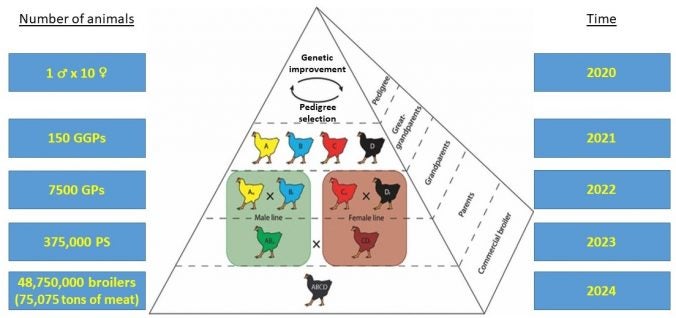Figure XX. A typical modern broiler chicken breeding program, represented as a pyramid where each level represents a generation, and the approximate timeline to move genetics from top of the broiler breeding pyramid to the consumer.
Most Recent Posts
- Addressing the 2050 Demand for Terrestrial Animal Source Food
- A decade since IQ2 GM Food Debate
- Funding Announced for Cooperative Research Centre (CRC) for Zero Net Emissions from Australian Agriculture
- Extension Critical to Mitigate Anticipated Increase in Livestock Sector GHG Emissions
- New York Times Reporting on Agriculture
 Biobeef Blog
Biobeef Blog
- Addressing the 2050 Demand for Terrestrial Animal Source Food December 2, 2024I have a paper entitled “Addressing the 2050 demand for terrestrial animal source food”, in @PNASNews Special Feature on the Sustainability of Animal-Sourced Foods and Plant-Based Alternatives., published today. This Feature includes several articles that consider the sustainability implications of replacing milk, meat and eggs with alternative proteins at scale. The significance statement (aka the […]
- A decade since IQ2 GM Food Debate December 1, 2024Ten years ago on December 3, 2014, I participated in an Intelligence Squared (IQ2) debate in the Kaufmann theater New York City. The topic was “Genetically Modify Food”, and unexpectedly following the 90-min debate the side arguing for GMO Food, myself and Monsanto executive vice president and chief technology officer Rob Fraley, swayed a large […]
- Funding Announced for Cooperative Research Centre (CRC) for Zero Net Emissions from Australian Agriculture December 12, 2023AMAZING. Today the Australian Government Department of Industry, Science, Energy and Resources announced it is funding the Cooperative Research Centre (CRC) for Zero Net Emissions from Agriculture (ZNE-Ag) to the tune of AUD $87 million to further develop and scale up technologies to reduce methane emissions from grazing cattle and sheep, and to improve crop […]
- Extension Critical to Mitigate Anticipated Increase in Livestock Sector GHG Emissions December 11, 2023A 2023 report from the FAO “Pathways towards lower emissions: A global assessment of the greenhouse gas emissions and mitigation options from livestock agrifood systems” revised their previous lifecycle assessment (LCA) estimate of the percentage of greenhouse gas (GHG) due to livestock to be 6.2 gigatonnes (Gt) of carbon dioxide equivalent (CO2eq), equating to approximately […]
- New York Times Reporting on Agriculture November 1, 2022Look I get it. The New York Times (NYT) does not like GMOs, industrial agriculture, factory farming or meat consumption. But I question the decision of such an influential media source to feature TWO front page articles detailing agriculture industry funding of agricultural scientists, Prof. Kevin Folta in 2015 and in 2022 Prof. Frank Mitloehner, […]
Archives
Archives
- December 2024
- December 2023
- November 2022
- July 2022
- March 2022
- October 2021
- December 2020
- February 2020
- December 2019
- October 2019
- April 2019
- January 2019
- August 2018
- January 2018
- December 2017
- September 2017
- July 2017
- May 2017
- February 2017
- January 2017
- December 2016
- April 2016
- March 2016
- February 2016
